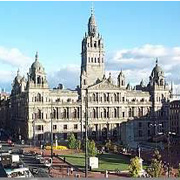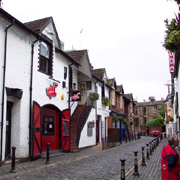英国城市--格拉斯哥
Glasgow (UK)
 Glasgow's history stretches back almost two thousand years and has been rich and varied. Originally a small salmon-fishing village at a crossing point on the River Clyde, Glasgow has been shaped by Battles, World Wide Trade and Heavy Industry to become a truly International City.
Glasgow's history stretches back almost two thousand years and has been rich and varied. Originally a small salmon-fishing village at a crossing point on the River Clyde, Glasgow has been shaped by Battles, World Wide Trade and Heavy Industry to become a truly International City.
Founded by a Christian missionary (St Mungo), Glasgow became a major religious centre. Mungo's original church was destroyed by the wars which swept the country in the years after his death. Today's Cathedral dates from the 12th Century and has been added to in the years which followed.
Provand's Lordship, the oldest house in Glasgow was built over 500 years ago for the Lord of Provan, an official of the Cathedral. The house still welcomes visitors today to view its proud history.
In 1451 Glasgow became a University City. Glasgow University was originally built in the High Street area of the city, but was moved to its present site in Glasgow's West end in 1870.
Glasgow has also been the site of many battles. Bishop's Castle once stood on the site now occupied by Glasgow's Royal Infirmary. Here, in 1300, William Wallace (of "Braveheart" fame) with 300 men defeated an army of 1000 English Knights who had taken possession of the castle under the English Bishop of Durham.
Two centuries later the castle was again the scene of battle when two opposing forces fought for control of the Crown of Scotland then in the possession of the baby, Mary Queen of Scots.
Due to its location on the west of the country, Glasgow was well positioned to send shipping to the West Indies and America. By the 18th century many merchants had acquired great wealth by importing sugar, rum and tobacco. Thus were born the Tobacco Lords who built fabulous mansions (大厦)in the city.
 However, life was very different for the city's poor. By the 19th century the influx (流入)of people looking for employment spawned the emergence of tenement (房屋)accommodation. The poorest families were forced to live in "single ends", one roomed homes where the entire family, often including grandparents, would live together. An example is displayed at The People's Palace. Many families had to share common lavatories and wash facilities.
However, life was very different for the city's poor. By the 19th century the influx (流入)of people looking for employment spawned the emergence of tenement (房屋)accommodation. The poorest families were forced to live in "single ends", one roomed homes where the entire family, often including grandparents, would live together. An example is displayed at The People's Palace. Many families had to share common lavatories and wash facilities.
However, the struggle for survival generated a common bond between the tenement dwellers and a great sense of community spirit, kindness and sharing dominated everyday life.
The existence of vast deposits of coal and iron ore (矿石)in the Glasgow area shaped the next two centuries of Glasgow's history.
With the coming of the Industrial Revolution, aided by technological advances designed by Clydeside inventors such as James Watt, Heavy Industry in the shape of Railway Locomotives and Shipbuilding flourished.
Locomotives were exported throughout the world. "Clyde-Built" became synonymous (同义的)with quality and reliability. The launch of the three "Queens" - luxury passenger liners - was the pinnacle (顶点)of Glasgow's shipbuilding achievement. (Many of the original shipping models are on display in the beautiful "Clyde Room" at the Transport Museum)
Sadly, the changing pattern of industry means that the Clyde no longer employs the vast throngs of workers in the shipbuilding trades, although there are notable exceptions. The proud "Clyde-Built" traditions are still in evidence among the workforces of Kvaerner Govan and Yarrows, to name but two of Clydeside's remaining shipbuilding yards.
Today the city beckons tourists from all over the world. Glasgow's art treasures are world renowned and most of the city's museums and art galleries offer free entrance to view their treasures. The city boasts a fine Concert Hall, International Conference Centre, Science Centre, Sports Arena and shops rivalling the best in the land.
All this combined with Glasgow's unique friendliness and hospitality makes the city a favourite destination for visitors from all nations.